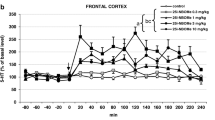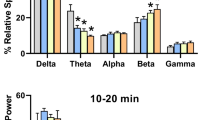Summary
Electrophysiological studies using spectral analysis techniques were undertaken in rabbits to determine whether or not hippocampal rhythmical slow activity (RSA, theta wave activity) was affected by the 5-hydroxytryptamine1A (5-HT1A) agonists 8-hydroxy-2-(di-n-propylamino) tetralin (8-OH-DPAT) and 3 α, 4 β, 7 β, 7 α-hexahydro-2-(4-(4-(2-pyrimidinyl)-1-piperazinyl)-butyl)-4, 7-methano-IH-isoindole-1,3(2H)-dione dihydrogen citrate (SM-3997, a newly synthesized anxiolytic drug). Intravenous administration of 8-OH-DPAT and SM-3997 induced a desynchronized pattern with low-amplitude slow wave activity in the hippocampal EEG and inhibited RSA generation following stimulation of the midbrain reticular formation. RSA was also inhibited by 5-HT1A related anxiolytics such as buspirone, gepirone, and ipsapirone. The effects of 8-OH-DPAT and SM-3997 on the hippocampal RSA were blocked by pindolol, which has 5-HT1A antagonistic activity. Direct microinjection of these 5-HTIA selective agonists into the hippocampus inhibited generation of the hippocampal RSA. These findings indicated that 8-OH-DPAT and SM-3997 inhibited the hippocampal RSA by acting on hippocampal 5-HTIA receptors.
Similar content being viewed by others
References
Assaf SY, Miller JJ (1978) The role of a raphe serotonin system in the control of septal unit activity and hippocampal desynchronization. Neuroscience 3:539–550
Buzsáki G, Leung L-WS, Vanderwolf CH (1983) Cellular bases of hippocampal EEG in the behaving rat. Brain Res Rev 6:139–171
Carli M, Samanin R (1988) Potential anxiolytic properties of 8-hydroxy-2-(di-N-propylamino)tetralin, a selective serotonin1A receptor agonist. Psychopharmacology 94:84–91
Elazar Z, Adey WR (1967) Spectral analysis of low frequency components in the electrical activity of the hippocampus during learning. Electroencephalogr Clin Neurophysiol 23:225–240
Gozlan H, El Mestikawy S, Pichat L, Glowinski J, Hamon M (1983) Identification of presynaptic serotonin autoreceptors using a new ligand: 3H-PAT. Nature 305:140–142
Grastyan E, Karmos G, Vereczkey L, Kellenyi L (1966) The hippocampal electrical correlates of the homeostatic regulation of motivation. Electroencephalogr Clin Neurophysiol 21:34–53
Gudelsky GA, Koenig JI, Meltzer HY (1986) Thermoregulatory responses to serotonin (5-HT) receptor stimulation in the rat: Evidence for opposing roles of 5-HT2 and 5-HT1A receptors. Neuropharmacology 25:1307–1313
Hall MD, El Mestikawy S, Emerit MB, Pichat L, Hamon M, Gozlon H (1985) 3H-8-hydroxy-2-(di-n-propylamino)tetralin binding to pre- and postsynaptic 5-hydroxytryptamine sites in various regions of the rat brain. J Neurochem 44:1685–1696
Herrick-Davis K, Titeler M (1988) Detection and characterization of the serotonin 5-HT1D receptor in rat and human brain. J Neurochem 50:1624–1631
Hirose A, Sasa M, Akaike A, Takaori S (1988) Inhibition of the hippocampal pyramidal neurons by SM-3997, a new 5-hydroxytryptamine1A agonist. Jpn J Pharmacol 46:238P
Hirose A, Sasa M, Akaike A, Takaori S (1989) Electroencephalographic study on the central action of a new anxiolytic: 3α, 4β, 7β, 7α-hexahydro-2-(4-(4-(2-pyrimidinyl)-1-piperazinyl)butyl)-4,7-methano-1H-isoindole-1,3(2H)-dione dihydrogen citrate (SM-3997). Folia Pharmacol Jpn 93:41–47
Hutson PH, Dourish CT, Curzon G (1986) Neurochemical and behavioural evidence for mediation of the hyperphagic action of 8-OH-DPAT by 5-HT cell body autoreceptors. Eur J Pharmacol 129:347–352
Hutson PH, Dourish CT, Curzon G (1988) Evidence that the hyperphagic response to 8-OH-DPAT is mediated by 5-HT1A receptors. Eur J Pharmacol 150: 361–366
Kemp IR, Kaada B (1975) The relation of hippocampal theta activity to arousal, attentive behavior and somato-motor, movements in unrestrained cats. Brain Res 95:323–342
Koenig JI, Meltzer HY, Gudelsky GA (1988) 5-Hydroxytryptamine1A receptor-mediated effects of buspirone, gepirone and ipsapirone. Pharmacol Biochem Behav 29:711–715
Kramis R, Vanderwolf CH, Bland BH (1975) Two types of hippocampal rhythmical slow activity in both the rabbit and the rat: Relations to behavior and effects of atropine, diethyl ether, urethane, and pentobarbital. Exp Neurol 49:58–85
Marcinkiewicz M, Verge D, Gozlan H, Pichat L, Hamon M (1984) Autoradiographic evidence for the heterogeneity of 5-HT1 sites in the rat brain. Brain Res 291:159–163
Maru E, Takahashi LK, Iwahara S (1979) Effects of median raphe nucleus lesions on hippocampal EEG in the freely moving rat. Brain Res 163:223–234
McNaughton N, Richardson J, Gore C (1986) Reticular elicitation of hippocampal slow waves: Common effects of some anxiolytic drugs. Neuroscience 19:899–903
Middlemiss DN, Buxton DA, Greenwood DT (1981) Betaadrenoceptor antagonists in psychiatry and neurology. Pharmacol Ther 12:419–437
Middlemiss DN, Fozard JR (1983) 8-Hydroxy-2-(di-n-propylamino)-tetralin discriminates between subtypes of the 5-HT1 recognition site. Eur J Pharmacol 90:151–153
Moore RY, Halaris AE, Jones BE (1978) Serotonin neurons of the midbrain raphe: ascending projections. J Comp Neurol 180:417–438
Peroutka SJ (1985) Selective interaction of novel anxiolytics with 5-hydroxytryptaminc1A receptors. Biol Psychiatry 20:971–979
Sawyer CH, Everett JW, Green JD (1954) The rabbit diencephalon in stereotaxic coordinates. J Comp Neurol 101:801–824
Shimizu H, Hirose A, Tatsuno T, Nakamura M, Katsube J (1987) Pharmacological properties of SM-3997: A new anxioselective anxiolytic candidate. Jpn J Pharmacol 45:493–500
Shimizu H, Karai N, Hirose A, Tatsuno T, Tanaka H, Kumasaka Y, Nakamura M (1988a) Interaction of SM-3997 with serotonin receptors in rat brain. Jpn J Pharmacol 46:311–314
Shimizu H, Tatsuno T, Hirose A, Tanaka H, Kumasaka Y, Nakamura M (1988b) Characterization of the putative anxiolytic SM-3997 recognition sites in rat brain. Life Sci 42:2419–2427
Smith LM, Peroutka SJ (1986) Differential effects of 5-hydroxytryptamine1A selective drugs on the 5-HT behavioral syndrome. Pharmacol Biochem Behav 24:1513–1519
Stumpf C (1965) Drug action on the electrical activity of the hippocampus. Int Rev Neurobiol 8:77–138
Traber J, Glaser T (1987) 5-HT1A receptor-related anxiolytics. Trends Pharmacol Sci 8:432–437
Author information
Authors and Affiliations
Additional information
Send offprint requests to A. Hirose at the above address
Rights and permissions
About this article
Cite this article
Hirose, A., Tsuji, R., Shimizu, H. et al. Inhibition by 8-hydroxy-2-(di-n-propylamino) tetralin and SM-3997, a novel anxiolytic drug, of the hippocampal rhythmical slow activity mediated by 5-hydroxytryptamine1A receptors. Naunyn-Schmiedeberg's Arch Pharmacol 341, 8–13 (1990). https://doi.org/10.1007/BF00195051
Received:
Accepted:
Issue Date:
DOI: https://doi.org/10.1007/BF00195051




